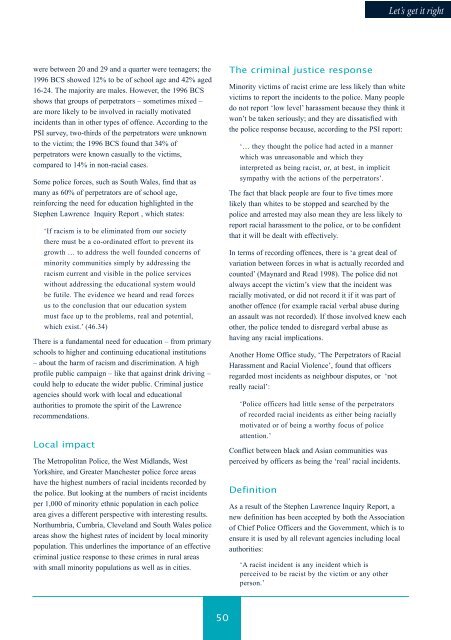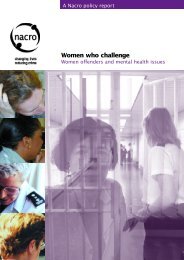Let's get it right: race and justice 2000 - Nacro
Let's get it right: race and justice 2000 - Nacro
Let's get it right: race and justice 2000 - Nacro
- No tags were found...
Create successful ePaper yourself
Turn your PDF publications into a flip-book with our unique Google optimized e-Paper software.
Let’s <strong>get</strong> <strong>it</strong> <strong>right</strong>were between 20 <strong>and</strong> 29 <strong>and</strong> a quarter were teenagers; the1996 BCS showed 12% to be of school age <strong>and</strong> 42% aged16-24. The major<strong>it</strong>y are males. However, the 1996 BCSshows that groups of perpetrators – sometimes mixed –are more likely to be involved in racially motivatedincidents than in other types of offence. According to thePSI survey, two-thirds of the perpetrators were unknownto the victim; the 1996 BCS found that 34% ofperpetrators were known casually to the victims,compared to 14% in non-racial cases.Some police forces, such as South Wales, find that asmany as 60% of perpetrators are of school age,reinforcing the need for education highlighted in theStephen Lawrence Inquiry Report , which states:‘If racism is to be eliminated from our societythere must be a co-ordinated effort to prevent <strong>it</strong>sgrowth … to address the well founded concerns ofminor<strong>it</strong>y commun<strong>it</strong>ies simply by addressing theracism current <strong>and</strong> visible in the police servicesw<strong>it</strong>hout addressing the educational system wouldbe futile. The evidence we heard <strong>and</strong> read forcesus to the conclusion that our education systemmust face up to the problems, real <strong>and</strong> potential,which exist.’ (46.34)There is a fundamental need for education – from primaryschools to higher <strong>and</strong> continuing educational inst<strong>it</strong>utions– about the harm of racism <strong>and</strong> discrimination. A highprofile public campaign – like that against drink driving –could help to educate the wider public. Criminal <strong>justice</strong>agencies should work w<strong>it</strong>h local <strong>and</strong> educationalauthor<strong>it</strong>ies to promote the spir<strong>it</strong> of the Lawrencerecommendations.Local impactThe Metropol<strong>it</strong>an Police, the West Midl<strong>and</strong>s, WestYorkshire, <strong>and</strong> Greater Manchester police force areashave the highest numbers of racial incidents recorded bythe police. But looking at the numbers of racist incidentsper 1,000 of minor<strong>it</strong>y ethnic population in each policearea gives a different perspective w<strong>it</strong>h interesting results.Northumbria, Cumbria, Clevel<strong>and</strong> <strong>and</strong> South Wales policeareas show the highest rates of incident by local minor<strong>it</strong>ypopulation. This underlines the importance of an effectivecriminal <strong>justice</strong> response to these crimes in rural areasw<strong>it</strong>h small minor<strong>it</strong>y populations as well as in c<strong>it</strong>ies.The criminal <strong>justice</strong> responseMinor<strong>it</strong>y victims of racist crime are less likely than wh<strong>it</strong>evictims to report the incidents to the police. Many peopledo not report ‘low level’ harassment because they think <strong>it</strong>won’t be taken seriously; <strong>and</strong> they are dissatisfied w<strong>it</strong>hthe police response because, according to the PSI report:‘… they thought the police had acted in a mannerwhich was unreasonable <strong>and</strong> which theyinterpreted as being racist, or, at best, in implic<strong>it</strong>sympathy w<strong>it</strong>h the actions of the perpetrators’.The fact that black people are four to five times morelikely than wh<strong>it</strong>es to be stopped <strong>and</strong> searched by thepolice <strong>and</strong> arrested may also mean they are less likely toreport racial harassment to the police, or to be confidentthat <strong>it</strong> will be dealt w<strong>it</strong>h effectively.In terms of recording offences, there is ‘a great deal ofvariation between forces in what is actually recorded <strong>and</strong>counted’ (Maynard <strong>and</strong> Read 1998). The police did notalways accept the victim’s view that the incident wasracially motivated, or did not record <strong>it</strong> if <strong>it</strong> was part ofanother offence (for example racial verbal abuse duringan assault was not recorded). If those involved knew eachother, the police tended to disregard verbal abuse ashaving any racial implications.Another Home Office study, ‘The Perpetrators of RacialHarassment <strong>and</strong> Racial Violence’, found that officersregarded most incidents as neighbour disputes, or ‘notreally racial’:‘Police officers had l<strong>it</strong>tle sense of the perpetratorsof recorded racial incidents as e<strong>it</strong>her being raciallymotivated or of being a worthy focus of policeattention.’Conflict between black <strong>and</strong> Asian commun<strong>it</strong>ies wasperceived by officers as being the ‘real’ racial incidents.Defin<strong>it</strong>ionAs a result of the Stephen Lawrence Inquiry Report, anew defin<strong>it</strong>ion has been accepted by both the Associationof Chief Police Officers <strong>and</strong> the Government, which is toensure <strong>it</strong> is used by all relevant agencies including localauthor<strong>it</strong>ies:‘A racist incident is any incident which isperceived to be racist by the victim or any otherperson.’50

















